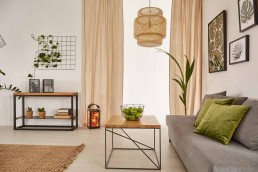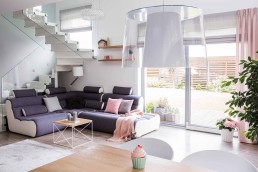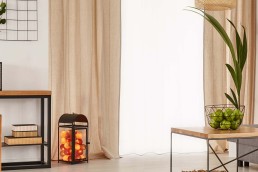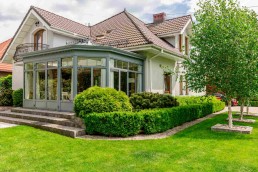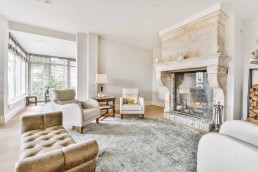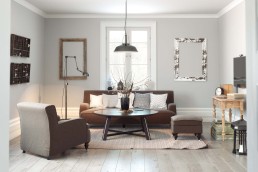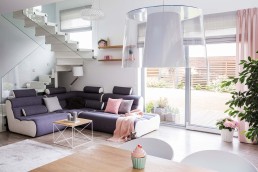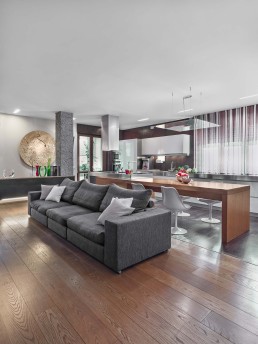The Ultimate Guide to Window Treatments
Window treatments are the finishing touch that determines what kind of style a home has. They are considered as a necessity to any home, not only for the aesthetic but also for functionality purposes. From curtains to blinds, there are tons of options that you can choose that can also vary in colour and material. Selecting the right window treatments for your home is very important, considering that they could separate a well decorated home from an amazing one. Since the variations of window treatments are never ending, it may be overwhelming and difficult to know where to start your search. So, here is the ultimate guide of things to consider when purchasing window treatments.
Window Size and Shape
Arched, circular, rectangular, and bay windows are the most popular window designs. It should be remembered that most of the options are composed of three rectangular windows and can be difficult to furnish. You need to consider how the window opens in addition to its design, since this might determine the sort of covering required. Double/single hung windows, for example, glide vertically from the bottom up, whereas awning windows open from the bottom out. Furthermore, sliding windows open from one side to the other, while casement windows open like a door. All of these type of characteristics are important to know because they can greatly affect your decisions on what window treatments you will choose.
Purpose of Window Treatment
Before making any decisions, consider what the window treatment will be used for. Are they for appearance, functionality, or both? Knowing the answers to these questions will help you decide what is best for the home. For example, if you are troubled by the volume of light that enters your home and want to purchase a window covering that specialises in UV protection, blinds and solar shades are the ideal options. Furthermore, a new pair of curtains might suit your wants if you want to spice up the aesthetic of your house with something different. Additionally, blackout curtains and cellular shades can solve any privacy issues you and your house may be experiencing.
Window Treatment Options
Everyone who has looked at the many sorts of window coverings available is aware that there are several variations and materials to pick from. By understanding the different styles and materials, you will be able to choose the best option for your home. Curtains, drapes, blinds, shades, and valances are the most common types of window treatments. Curtains are often constructed of sheer cotton or polyester, making them ideal for aesthetic purposes. Drapes are commonly constructed of velvet, silk, and polyester, which makes them thicker and more effective in blocking out light. Blinds are typically constructed of wood and are excellent for controlling light. Shades are one of the most popular window treatments among the general public. They can do a number of things, like UV blocking and trapping air inside the house, depending on what type of shades you get. Valances is an additionional layer that you can apply to any of the window coverings mentioned above.
Cleaning Window Coverings
Dusting and light vacuuming on a regular basis helps preserve the quality and durability of your window coverings. However, once in a while, thorough cleaning is required for your coverings. For instance, to make sure that your curtains and drapes are really clean, a quick machine wash would be helpful. For blinds, dusting and vacuuming them can do the job, but to clean them thoroughly, carefully washing them with a mix of detergent and a bit of water is recommended. In addition, shades need constant dusting and light vacuuming in order to keep them in their best condition.
There are many factors that you have to take into account when choosing new window treatments. You have to be mindful of your windows’ size and shape, the purpose of your new coverings, the details of the options that you are choosing from and how to clean the type of window treatment that you are considering. By being familiar with all of this, you will be able to effectively choose the right window coverings for you and your home.
What Are The Benefits Of Roman Shades?
Window treatments are beneficial in any room, whether it is your office, living room or your bedroom. Although there are many types of window treatments, a popular option that can fit in with almost any room decor and is often recommended by professionals are roman shades. They come in many variations of fabrics and are versatile when it comes to matching the wanted aesthetics of your home. Not only do Roman shades look great, but they are also highly functional.
Here is an in-depth breakdown of roman shades and why they are beneficial to have:
Versatile and Timeless
Due to their unique design, they can fit the aesthetic of almost any home. Depending on the colour and fabric you choose, roman shades can be used for any setting, whether it is for privacy or for formality. No matter the room, from your living room to your home office, roman shades will complete the space.
Energy Efficiency
Roman shades are one of several types of window coverings that can help your home be more energy efficient. Depending on the fabric you choose, this type of window covering can either allow sunlight into your home or block it entirely. They also perform well in controlling temperature when compared to other types of window coverings. For example, during the winter, you can open your shades up in a way that will allow sunlight to enter your home to help warm your home and during the summer, you can completely shut your shades to prevent light from coming in and heating your home.
Safety
When it comes to window coverings, many parents and pet owners are concerned about the dangling cords and the potential harm they can cause to children and pets. With Roman shades, you can have the option to motorize the functionality eliminating the need for a cord for operation. Due to the fact that there is no cord, it almost completely eliminates the possibilities of any hazards posed towards children or pets.
Easily Customizable
Roman shades are available in a variety of different designs, each of which adds a distinct appearance and feel to the room. One common pattern that is worth mentioning are borders. Borders are a one-of-a-kind blend of several materials designed to complement certain colour schemes. You may choose the style, colour, texture, shape, size, functionality, and material of your Roman shades. This guarantees that they complement your taste and lifestyle, as well as the rest of your home's design. Customization also guarantees that the shades are a perfect fit for your windows, providing optimum coverage and protection.
Roman shades are a popular choice when it comes to window coverings for your home, they come in a variety of designs and materials that are versatile and timeless, making it easy to find the right one for your home’s aesthetic. Not only are they pleasing to the eye, but they are highly functional as well. They are less likely to pose safety hazards and they are also energy efficient. If you are looking for new window treatment, Roman shades are definitely a style to consider.
How To Find Out The Best Window Treatment For Your Space
Are you thinking of replacing your window coverings? Well, you should keep reading further! We know that your window coverings represent your home’s style and design, but that they also offer privacy, can provide that extra touch of natural light when needed and can be a focal point in any room. But, the most common challenge homeowners face when looking to replace their window coverings is, which is the best option for my home? This is where we come in.
Here’s how to find the best window treatment for your space in 2022. Let’s see which window covering suits you best!
Curtains
Curtains are a versatile window covering that can offer the perfect styling for a home. You can achieve almost any look with curtains, including a bold or welcoming look. It is worth noting that curtains have a say in the overall design of a room. For example, if you use heavy curtains, you’ll manage to create a sophisticated room. We recommend curtains if you want to express your personality. Living rooms can benefit the most from such window coverings since curtains look amazing when paired with larger windows.
Roman Shades
Roman shades represent a popular window covering selection with almost all homeowners. They are attractive and available in different fabrics and colours. These coverings are subtle and can fit nicely into any window area. Roman shades let in plenty of natural light while maintaining your privacy. We recommend roman shades for bathrooms, kitchens, or areas with little to no wall space around the window frame..
Cellular Shades
Cellular shades are an affordable and practical window treatment solution. These are available in different colours but are limited in terms of design. Cellular shades are simple and can match almost any type of interior design. We recommend these window coverings for areas that require plenty of privacy, such as bedrooms.
Shutters
Shutters are perfect for those looking for an elegant and traditional vibe. These can become a bold statement, too, no matter the size of the space. Shutters are usually designed in brown, black, or white offering a classic look. We recommend shutters for homes that have a more traditional or sophisticated design.
Vertical Blinds
Vertical blinds are affordable, stylish, and suitable for almost any room. The main advantage of using vertical blinds is the ease of maintenance. We recommend these blinds for large windows. They are simple to operate and can block sunlight when needed. Vertical blinds can improve energy efficiency when installed correctly.
No matter which window covering you have in mind, it is always recommended to look into different treatment options before making your final selection. Each window covering has its own set of advantages and disadvantages. You can choose the best solution for your home based on your needs and expectations. The window coverings in this article represent a great start if you want to boost the visual appeal and privacy of your home.
5 Types Of Window Coverings That Protect Your Home From The Cold
Window coverings provide additional protection against the cold and air leaks in homes. They can serve as a window insulation to maintain indoor temperature. If you want to prevent extreme cold in your home, shielding your windows with high-quality window coverings is the right thing to do. There are different types of window coverings but some are more effective against the cold than others. So, here are 5 types of window coverings that protect your home from the cold:
1. Roman Blinds
One of the most popular and effective window coverings is the Roman blinds. They are classy, beautiful and gorgeous. They complement and enhance the charms of the interior decor and enliven the room. Although most Roman blinds are made of fabric, you can choose thermal fabric to protect your home from the cold. They will undoubtedly increase the insulation of your windows and prevent air leaks.
2. Roller Shades
Roller shades are another window covering that protects the home from cold. There are dual roller shades that are multipurpose - one reflective side and the other side absorbing heat. The sides can be reversed to meet the weather needs. Turning the reflective side inside the house and the insulated side outside will prevent the escape of warm air from the house and prevent the house from being filled with cold air.
3. Drapes and Curtains
Drapes and curtains usually have insulating properties. They are energy-efficient and are suitable for protecting the house from the cold. Choosing the right fabric for the drapes and curtains will enhance the insulation of the home and prevent air escape. Thick and dense drapes are best suited for combating cold. Fabrics like tweed, suede and velvet are the most appropriate - they will prevent heat loss from the home and keep cold out.
4. Cellular Honeycomb Shades
Other window coverings you can rely on to protect your house from the cold are the cellular honeycomb shades. They are among the best window coverings with the highest level of insulation. They come with pockets of cellular shades with air trapped inside, which acts as a layer of protection for the home against the cold air. They help retain the heat within the house and ensure that cold air does not reach the insides of the home.
5. Shutters
Shutters are another type of window coverings that can prevent air leaks during winter. They fit perfectly on the windows and provide a seal to prevent the cold from filtering into the house. Once the slats are closed, the shutters will provide a faultless seal and protect the home from the cold.
Takeaway
If you are searching for the best window coverings to protect your house from the cold, the window treatments above are the best choices for you. They will improve your house's energy efficiency and protect the house against drafts and air leaks.
Why Are Energy-efficient Window Coverings Important?
When considering ways to make a home more energy efficient, most homeowners focus on updating their windows, doors, insulation or roofing, however investing in energy efficient window coverings will help create a comfortable environment, reduce your energy consumption and add aesthetic touches to your home.
Below we discuss the reason why energy efficient window coverings are important.
What Are The Advantages of Energy Efficient Window Coverings?
There are a variety of energy efficient window covering styles available, each offering their own list of impressive benefits, but no matter the style of energy efficient window coverings you choose, the below benefits are encompassed by all:
- Reduced temperature fluctuations indoors
- Reduced energy bills
- Improved comfort
- Improved interior design
- Improved overall energy efficiency
Depending on the covering style you choose for your home, you’ll discover an array of additional benefits and advantages, below we highlight some of these styles and advantages.
#1 Cellular shades offer impressive insulation
Cellular shades are designed with an innovative design, they trap air within their honeycomb style pockets, which can significantly increase energy efficiency. Insulated cellular shades are considered to have the highest insulating properties of any window covering.
#2 Shutters offer impressive cooling properties during the warmer months
If you’re concerned about cooling costs during the summer months, window coverings can save you a lot of trouble. Shutters are created in such a way that they can help make your indoor spaces cooler during the summer months, by blocking sunlight when closed. These are excellent energy efficient window treatments and can withstand a lot of wear and tear.
#3 Roman shades offer attractive insulating characteristics
Roman shades are stylish and suitable for almost all types of interior design, but a lesser-known fact about these window coverings' importance is that they offer help in saving energy costs. Roman shades are designed with a thick insulating material that improves your energy efficiency. Roman shades help keep warm air in during the winter and cooler air in during summer. As a result, these window coverings represent a go-to solution for a long-term investment in an energy efficient window coverings.
#4 Solar shades will prevent heat gain
Solar shades diminish glare and shield your home’s interior from harmful UV rays as well as reduce heat gain. It is important to note that solar shades do not block the cold. We recommend pairing solar shades with other window covering styles, such as drapes. This will offer improved comfort and privacy within your home.
Adding energy efficient window coverings to your home is a great way to reduce energy consumption and save on your utility bills. They also offer the added bonus of aesthetic appeal, increased privacy and comfort. If you are not sure which window coverings are best suited for your needs and home design, be sure to discuss your options with a window coverings expert. They will review the different coverings options available and cover all of the benefits, advantages and energy efficient properties.
Why Are Window Coverings Important?
Renovating a house is an extensive project with plenty of expenses, when creating a budget many homeowners overlook the incorporating new window coverings. Window coverings represent any material used to cover a window. Such materials aim to manage sunlight and offer privacy, besides this, window coverings can significantly improve the energy efficiency of your windows.
Below, we share our insights on why window coverings are important.
Window Coverings Improve Quality Of Life and Sleep.
Window coverings offer improved comfort since they create excellent privacy. If you opt for large replacement windows, plenty of natural light will be allowed inside. But if you’re close to other homes or traffic, you might not feel as comfortable as you wish. Luckily, window coverings can offer much-needed privacy while still allowing natural light inside. Using this approach can offer many health benefits, including improved sleep.
Window Coverings Are Energy Efficient.
Another reason why window coverings are important is the fact that they are energy efficient. Energy efficiency is important as it can help you save by reducing utility costs. If you have just installed new energy efficient windows, energy efficient coverings will help increase the overall efficiency. If your windows are a little older these new coverings can help you achieve higher overall energy efficiency. For example, motorized blinds or shades provide the ability to time when they open and close. This lets you take advantage of natural light while providing ease of access to immediate privacy.
Window Coverings Boost Curb Appeal and Home Value.
Another reason why many people consider installing window coverings is that they significantly increase the value of a house. If you’re planning on selling your property in the near future, new window coverings are an appealing upgrade. Well-designed coverings make your home look professional designed, and can help open up or elongate a room. Prospective buyers will appreciate new window coverings because of their energy efficiency and pleasant appearance.
Window Coverings Are Customizable And Functional.
Windows represent the central element of any home, this means that installing window coverings can completely transform your home. A professional window covering stylist can measure and design window treatments to achieve a stylish interior. There are many high-quality window coverings available to choose from in different styles and materials. Almost all are extremely functional and help you manage natural light and improve energy efficiency.
Window coverings represent more than yet another stylish object in your home. They can boost privacy and can help you manage natural light that enters your home. Window coverings are a must in any home and have the power to change the look and feel of any room. Discuss your options with a window coverings expert at RS Window Fashions for additional insights into the best window covering solution for your home’s style and needs.
How Do I Choose A Good Window Covering?
If you haven’t looked into installing or replacing window coverings previously, you may be feeling a little overwhelmed at the number of options available. Roman shades, blinds, and curtains all boost the architectural design of a window. Personalized roman shades and draperies offer a boost of colour and texture while supporting the intimacy of a room. If you’re unsure which window coverings are suitable for your space, you’re in the right place.
This article discusses how to choose a good window covering today.
Think about your home’s architecture
The first thing you can do is think about your house’s architecture. Depending on the size and shape of your windows, you will need a covering that matches your window style well. It is a good idea to consider the molding around the window and how the window opens. All these aspects offer insights into the right window covering for your home’s architecture.
Think about interior design and window style
Windows come in different shapes and sizes. They suit different purposes, some are fixed and others open. Depending on your window type, you can start thinking about window coverings. The decorating style should match the colours and patterns. Our pro tip is to consider layering that incorporates a shade or a sheer curtain with something that blocks the light. This approach offers privacy when necessary and natural light when you want it. Overall, it would be best to choose a window covering style that matches all your furnishings.
Think about the purpose of your window coverings
Another key element to consider when choosing window coverings is the purpose of those coverings. For example, if you want to prevent light from entering, you have to opt for blackout lining. If you want to insulate a window, you have to use heavy lining. If you want to admire the view nearby easily, you can consider roller blinds or roman shades. If you’re focused on privacy, blinds and shades are a top choice for you. As you can see, there are plenty of options available. Before you choose a window covering, you should research the topic. A window expert can offer guidance on the best approach for your home.
Think about your room’s purpose.
Every room in your home serves a different purpose, this means that each room has distinct window coverings necessities. For example, you are better off with a blackout shade that will offer a relaxing atmosphere in a bedroom. If you are thinking about adding coverings in a media room, you will definitely want to use thick fabrics.
Think about colours, patterns, and prints.
Choosing window coverings should be a fun task, for most people this comes when choosing between various colours, patterns, and prints. You’ll want to look at what your room is missing. For example, you can achieve a lively ambiance with colourful window treatments. No matter what you opt for, new window coverings will offer an entirely updated appearance to any room.
The above tips are a few ways to choose the right window coverings for your home.We recommend you set up a budget before starting your search for window coverings so you don’t fall in love with coverings that are out of your price range.
What Are The Names For Window Coverings?
Window coverings are versatile and available in different shapes, sizes, styles and materials. With a wide range of different types of window coverings available, some which you probably didn’t even know about, it is easy to get overwhelmed when trying to choose the right window covering for your home. To help you sift through the different window covering styles, we are sharing a list of the most popular window coverings available.
So without further adieu, let’s explore what options are available.
Cellular shades
Cellular window coverings or cellular shades are honeycomb-designed cells suitable for proper ventilation. These coverings are great for helping insulate your home from any outdoor temperature fluctuations.
Layered window coverings
Layered coverings are an interesting approach in any home. These represent a double layer of fabric that alternates between opaque and colored stripes. Layered window coverings are an excellent solution for modern homes.
Natural shades
Natural shades are extremely popular because they are made from bamboo, jute, or reeds. Such interesting materials are woven together to let you roll up or down the covering. These shades are excellent for creating a relaxed ambiance.
Roman shades
Roman shades are a must for anyone that likes to be able to adjust the amount of light that can enter your home. These shades are versatile and fold up into large plates to allow more light inside. As a result, the interior will look stylish and welcoming.
Sheer window coverings
Sheer shades are interesting coverings similar to traditional blinds. These smoothly filter light with a sheer fabric positioned in between solid-colored fabrics. These offer excellent privacy while keeping your room cozy.
Traditional blinds
Traditional blinds have different textures, colours, and materials. These window coverings are extremely popular and are used in homes across Canada. Traditional blinds can be designed using wood, faux wood, vinyl, or aluminum materials.
Sliding panels
If you have a huge balcony or a door with a large window insert, sliding panels are a great option for you. These coverings are designed to retract and extend horizontally rather than vertically. Sliding panels are an excellent solution to sliding doors or tall vertical windows.
Shutters
Shutters are extremely stylish and offer a timeless appearance for any home. These window coverings are available in wood and composite wood. They are slightly pricier than some other covering options, but will last for a very long time.
Solar shades
Solar shades represent a go-to solution for those who focus on energy efficiency. These are similar to roller shades, and they are designed with fabrics that prevent UV rays from entering the room.
Roller shades
Roller shades provide a sleek appearance to any window style. These coverings are created with a single panel of fabric that rolls up. It is a top choice for homeowners who like their home without window coverings but still like to be able to maintain their privacy and cut out the natural light from time to time.
These are some of the most popular window coverings available for your home. Each has their own sets of benefits, and fit in different styles of homes and decor design. We encourage you to discuss your options with a window covering specialist before choosing a covering for your home.
How Often Should I Change My Window Coverings In My Room?
A question we receive often from our clients is “how often should I change my window coverings?” Your window coverings do not have an expiry date and can have different uses and purposes from one home to another. So, there is no one size fits all answer to this question. While most window coverings are decorative, they are also meant to serve other purposes such as providing privacy, preventing sunlight from entering the interior of a home and some are even insulating. Curtains, drapes, shutters, blinds, and shades are some of the most common types of window coverings used in many homes across Canada.
Like other items inside your home, your window coverings are not intended to last forever. So, changing them after some period of time is to be expected. But how often should you change the coverings in your room?
The Average Lifespan of Different Window Covering Types:
Since window coverings come in a variety of styles and types, it can be expected that the different types of coverings have a different average lifespan. Below we outline the average life expectancy of the different window covering types.
Window Blinds
Typically, blinds can last for a long period of time. High-quality blinds have been known to last for 20+ years. If your blinds are well-maintained, and are in good shape you won’t need to change them for up to 20 years as long as you are happy with the style and colour.
Curtains
Because curtains are made with delicate fabrics, they may not last as long as some other coverings, this also applies to most fabric drapes. By the end of their lifespan, most curtains and drapes would have been showing signs of raggedness as they may be fraying or have begun to fade due to constant sun exposure. Even if maintained properly, you can easily tell when it is time to change your curtains by their appearance. Most curtains should last at least 10 years, higher quality curtains can last longer, while lower quality curtains will show signs of wear sooner.
Shades
The average lifespan of shades depends on their maintenance. When maintained properly, window shades can be used for 10 to 15 years. If you are utilizing shades in your home, we recommend replacing them every 8 to 10 years.
Factors that May Lead to Changing Your Window Coverings
While each window covering has its own average lifespan, you may need to change them before that time comes. Here are some of the factors that may lead to you changing your window coverings early.
Trends and Fashion
When it comes to home interior design, the trends are constantly changing. Updating your window coverings is a fairly easy and inexpensive way to update the look and ambiance of a room or even your entire home. On the flip side, if you decorated your home to match a certain style, and you are no longer a fan of the look, updating your window coverings is an easy way to fall back in love with your home’s design.
Physical Damage
If your window coverings have become discolored due to sun exposure or if they are broken, torn, warped or damaged in any way, it is probably time to replace them. Damaged and worn window coverings take away from your home’s aesthetic as well; the coverings may not be able to shield your home from sunlight or offer full privacy.
Difficult to Operate
If you have to struggle in any way to open or close your window coverings, it may be time to look into changing them. If you have multiple window coverings that are giving you issues to operate, it may be time to update your window coverings across your entire home.
When it comes to changing the window coverings in your home, there is no hard and fast rule about how often and why you should be updating your coverings. If your coverings are of high quality and are in good condition, they can last 20+ years with some maintenance. However, even if your coverings are in great shape, but they do not match your interior design, updating them will give your entire home a new look and feel. If your older coverings are still in good condition when you replace them, consider donating them or passing them on to a friend for continued use.
5 Frequently Asked Questions About Window Coverings
Increasing the appeal of your home involves both aesthetics and practical function. As part of the décor of your home, window coverings are equally aesthetic and significant. Before investing in these window treatments to spruce up your home, it is only natural to have questions about their benefits and installation. We have listed frequently asked questions and the answers on what you need to know about window coverings.
1. What are window coverings?
Window coverings are enhancements for your home and windows. They are made from different materials and can come in the form of draperies, shutters, blinds, or shades. Each of these window covers have multiple functions from enhancing the décor of your home to privacy and regulating light.
2. Are window coverings energy-efficient?
Window coverings are a natural cooling system. Shades, in particular, can help to control the temperature of the home. They save energy by maintaining temperature in your home.
3. What are the most common types of window coverings?
Faux wood blinds, shutters, sunscreen shades, solar shades, and honeycomb shades are some of the most common types of window coverings. You can select from a wide variety of window coverings at a home improvement store online or near you.
4. Do my window coverings have to be installed by an expert or can I just do it myself?
Most people hire professionals to install their window coverings but if you are handy with a few tools, you can install these coverings yourself. Just follow the guide that comes with the package. If you encounter any issues while installing your window blind, you can reach out to the brand’s customer support or get a professional to finish the job.
5. Which window covering is best for my home?
The short answer, it depends on you. The longer answer, there are a variety of factors like taste, energy-efficiency, ongoing decor, budget, and brand that determines what window covering is best for your home. It is always recommended to go for top-notch quality coverings from credible brands and distributors.
6. What kind of window covering will be best for a simple outlook?
Your choice of window coverings ultimately depends on your taste and style choices. For a generally simple look, consider honeycomb shades, shutters, wood blinds, and roman blinds. It should be noted that window coverings with plain lines can also work great magic for a unique and simple outlook.
How to Choose the Perfect Window Shade for Your Home
By choosing the perfect window shade, you can easily revamp the overall look and atmosphere of your home. It can however be quite difficult to select the perfect window shade, as there are many eye-catching options available for you to choose from.
To help you select the perfect window shade for your home, we have outlined below several tips to consider when shopping for shades.
Know the various styles of shades available
Shades come in different styles, textures, fabric weights, and patterns, while most of these options will suffice in helping make a room look softer and warmer, some may be more suitable for your home than others. Knowing about the different types of shades you can find in the market will help you with your selection. The most common types of window shades are Roman shades, woven wood shades, blackout shades, solar shades, and honeycomb shades.
Choose shades that fit your window specifications
Before finalizing your selection of shades for your home, you should know the dimensions of your windows. Generally, your window should be measured from the top stitching line to the panel’s bottom. Once you have noted the specifications of your window, it will be easier for you to find or order shades that will perfectly fit your windows.
Think about the purpose of the room
The perfect window shade for your home must be suitable for the room you want to install it. If you don’t consider the purpose of a room, the shade may look out of place or not function as desired. For instance, if you are looking for window shades for a family room or dining room, Roman shades are an excellent option. A solar or roller shade will be perfect for a small home office and blackout shades are ideal for a bedroom. Take the time to consider the purpose of a specific room before choosing the style of window shade for it.
Consider the level of light control and privacy for the room
Each room in your home requires different levels of privacy and light control. Your bathrooms and bedrooms are personal spaces where you probably don’t want people to be able to see into, so the perfect window shade for such rooms must offer lots of privacy. Also, you may want to prevent light from coming into these rooms. In this case, you can select cellular shades.
However, for rooms where privacy may not be as large of a concern like your living room, you can opt to go with sheer window shades or other lightweight fabrics.
Choose shades that suit your taste
Everyone has a particular design preference when looking for window shades. It is important to consider your room's design and layout when making a final decision about your window shades. Individuals that want shades that are simple, elegant, and modern shouldn’t overlook Roman shades. However, cellular shades will be impeccable for anyone concerned about saving energy bills.
Create a budget
Having a budget that you are roughly prepared to spend on shades will help you narrow down your selection. While your budget may not be the #1 factor you want to consider, you should never overlook it. Keep in mind larger shades designed for larger windows will be costlier than those designed for smaller windows.
When selecting the perfect shade for your home, it should be an enjoyable experience as you have the ability to change the feel of a room or your entire home by changing the window coverings. There are many factors to consider including style, design, size, functionality and budget. If you are not sure where to begin your window shade search, contact your local window coverings specialist. They will be able to walk you through your different options and also suggest what shades would fit well in your home.
Why Are Electric Blinds Becoming So Popular?
Curtains used to be the conventional window coverings because of their simplicity in appearance, ease of use and pocket-friendly prices. However, with time, homeowners began shifting towards the use of window blinds for their windows when they discovered that blinds were better at blocking out light and offering more privacy.
Nowadays, we have electric window blinds, which are much more convenient than manual blinds. Motorized blinds are a good investment if you can have them installed in your home, they are safe, energy-efficient, easy to use and in the long run, you would be getting the value for your money. Here are 6 reasons why electric blinds are becoming so popular:
1. They Are Energy Efficient
Motorized blinds will save you a lot of money on energy bills because they help to conserve energy. Motorized blinds are excellent insulators (prevent heat loss) and they help regulate the amount of light entering your home. The interesting part is that you can automate your blinds to open and close at different times of the day, depending on the heat level.
2. They offer additional security.
If you have windows high up in your house, you can easily open or close them with a remote without risking any accidents that may occur while climbing to adjust the blinds.
3. Safety
Since motorized blinds can be automated to close and open at any time of the day, they can serve as a deterrent to burglars because it would appear as if you were at home, even if you aren’t. Electric blinds are also beneficial to your health because they can block UV light from the sun.
4. Variety Of Styles
Motorized blinds also come in various styles, colours and patterns. You can also choose between the ones that are controlled wirelessly or with switches. This means you are never out of options for a style that would complement the look of your home. Some electric blinds even come with applications that are specifically designed for the control of the blinds.
5.They increase home value
When potential buyers are looking for new properties, the ones with electric blinds are usually rated as high value and they are likely to attract buyers.
6. Ease of use
Motorized blinds are easy to install and easy to use because they require little technical know-how to operate them. Most motorized blinds run on home batteries that can be easily replaced, so you may not need an electrical connection to make them work.


